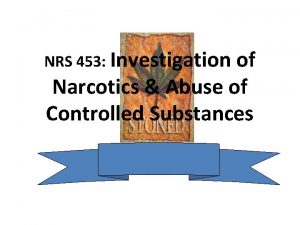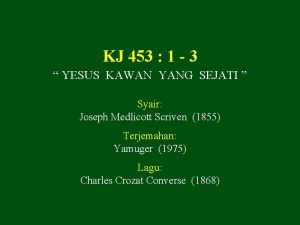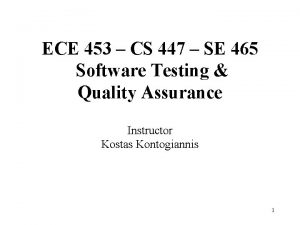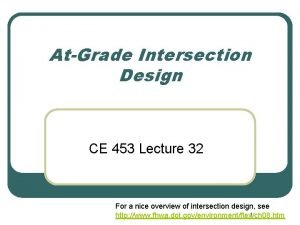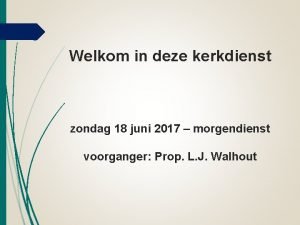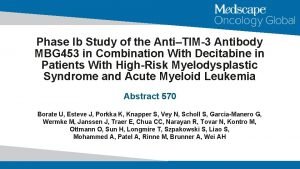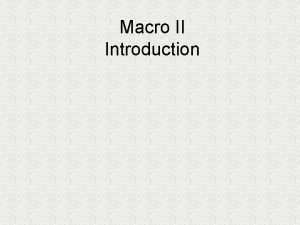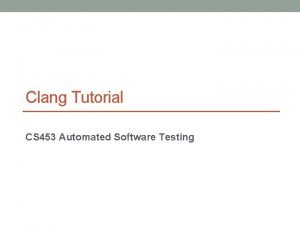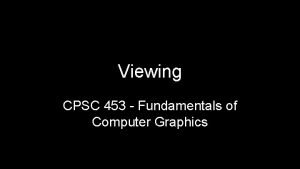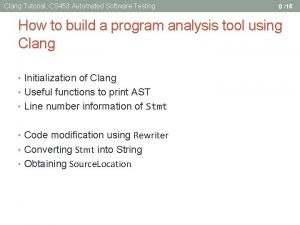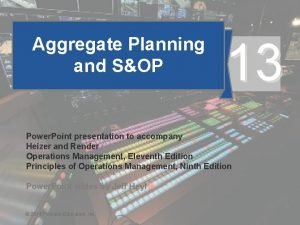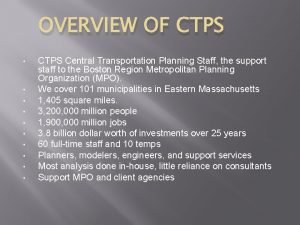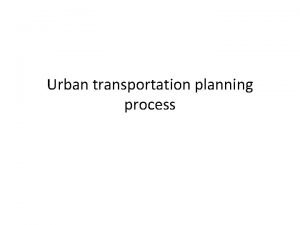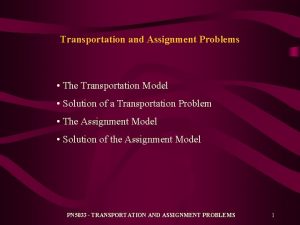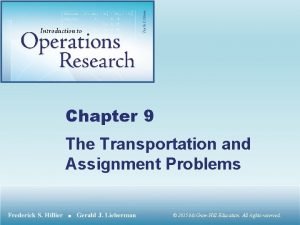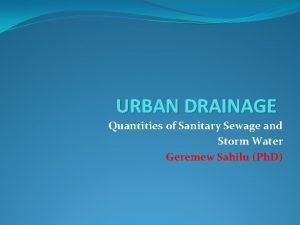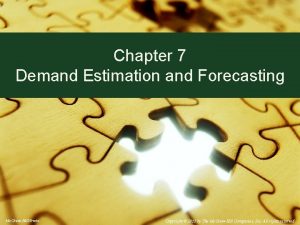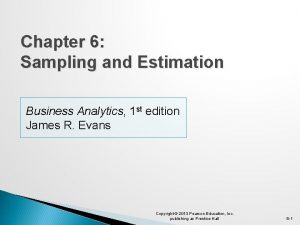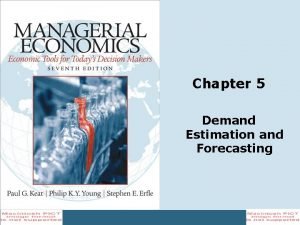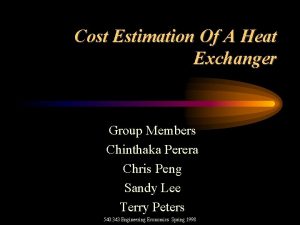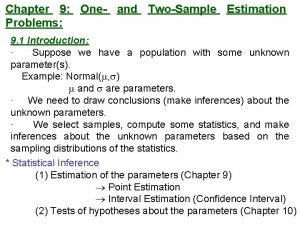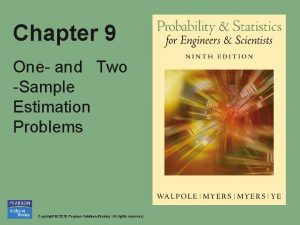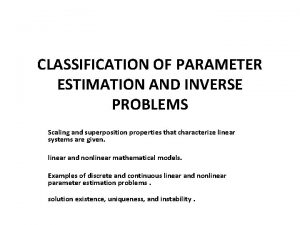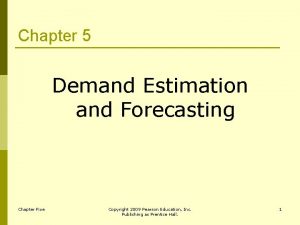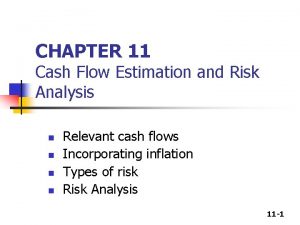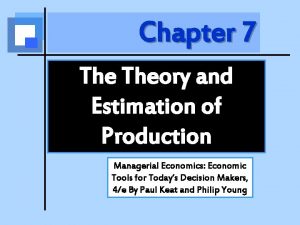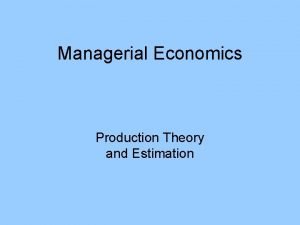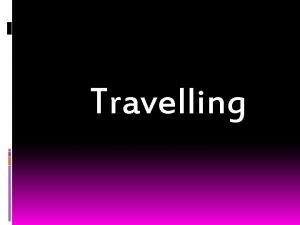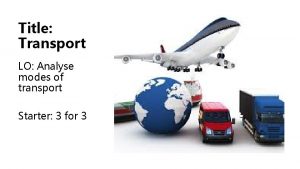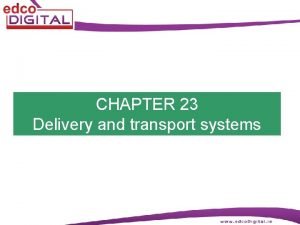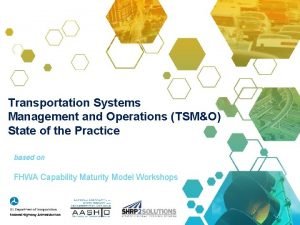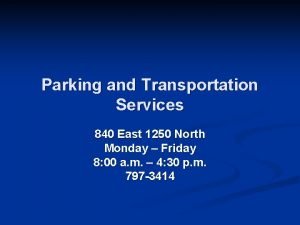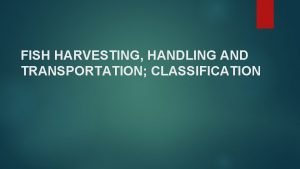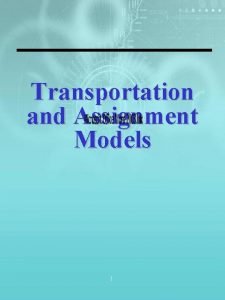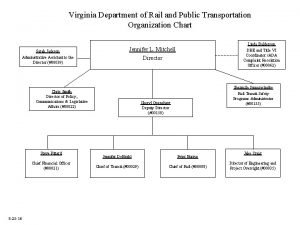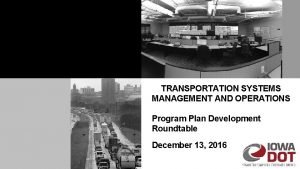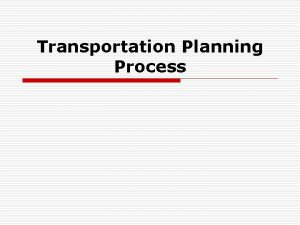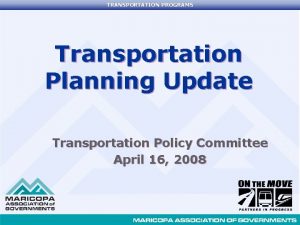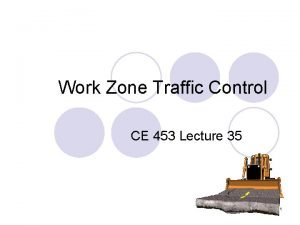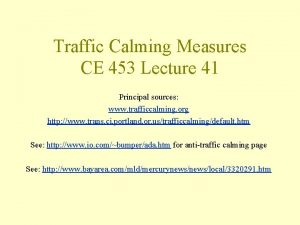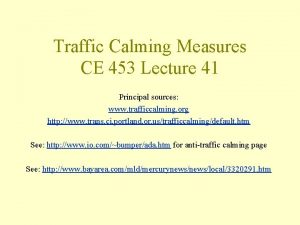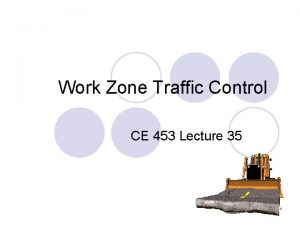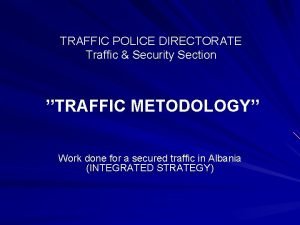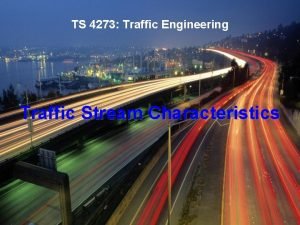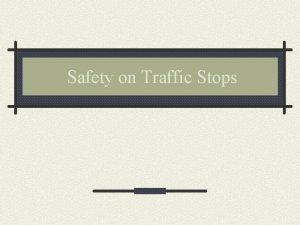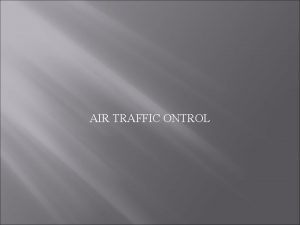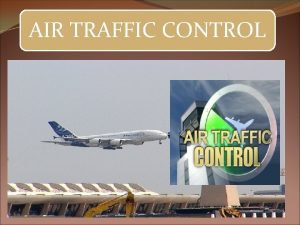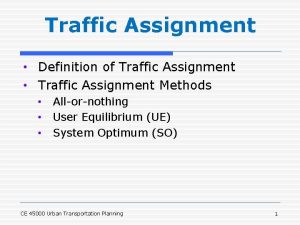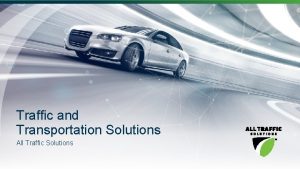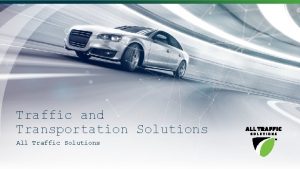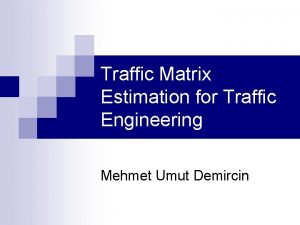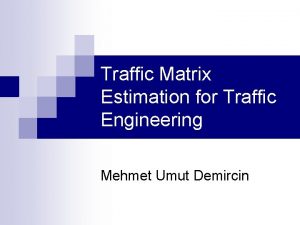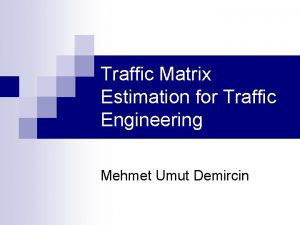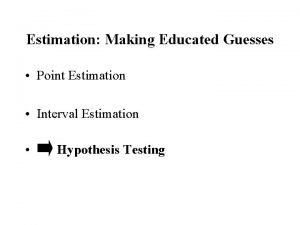Transportation Planning and Traffic Estimation CE 453 Lecture
































































- Slides: 64

Transportation Planning and Traffic Estimation CE 453 Lecture 5

Objectives 1. Identify highway system components 2. Define transportation planning 3. Recall the transportation planning process and its design purposes 4. Identify the four steps of transportation demand modeling and describe modeling basics. 5. Explain how transportation planning and modeling process results are used in highway design.

Highway System Components 1. Vehicle 2. Driver (and peds. /bikes) 3. Roadway 4. Consider characteristics, capabilities, and interrelationships in design Start with demand needs (number of lanes? )

Transportation Planning (one definition) Activities that: 1. Collect information on performance 2. Identify existing and forecast future system performance levels 3. Identify solutions Focus: meet existing and forecast travel demand

Where does planning fit in?

Transportation Planning in Highway Design 1. identify deficiencies in system 2. identify and evaluate alternative alignment impacts on system 3. predict volumes for alternatives • in urban areas … model? … smaller cities may not • need (few options) in rural areas … use statewide model if available … else: see lab 3 -type approach (note Iowa is developing a statewide model)




Truck Traffic


Planning at 3 levels l l l State … STIP Statewide Transportation Improvement Program (list of projects) Regional … MPO Metropolitan Planning Organization (>50, 000 pop. ), 25 year long range plan and TIP (states now also do LRP) Local …project identification and prioritization

Four Steps of Conventional Transportation Modeling 1. Trip Generation 2. Trip Distribution 3. Mode Split 4. Trip Assignment

Study Area l Clearly define the area under consideration • Where does one entity end? • May be defined by county boundaries, jurisdiction, town centers

Study Area l l May be regional Metropolitan area – Des Moines including suburbs, Ankeny, etc. • l Overall impact to major street/highway network Local – e. g. , impact of trips to new Ames mall • Impact on local street/highway system • Impact on intersections • Need for turning lane or new signal – can a model do this level of detail?

Study Area l l l Links and nodes Simple representation of the geometry of the transportation systems (usually major roads or transportation routes) Links: sections of roadway (or railway) Nodes: intersection of 2+ links Centroids: center of TAZs Centroid connectors: centroid to roadway network where trips load onto the network

Travel Analysis Zones (TAZs) l l Homogenous urban activities (generate same types of trips) • Residential • Commercial • Industrial May be as small as one city block or as large as 10 sq. miles Natural boundaries --- major roads, rivers, airport boundaries Sized so only 10 -15% of trips are intrazonal

www. sanbag. ca. gov/ planning/subr_ctp_taz. html

Four Steps of Conventional Transportation Modeling l l Divide study area into study zones 4 steps • • Trip Generation • -- decision to travel for a specific purpose (eat lunch) Trip Distribution • -- choice of destination (a particular restaurant? The nearestaurant? ) Mode Choice • -- choice of travel mode (by bike) • -- choice of route or path (Elwood to Lincoln to US 69) Network Assignment

Model Step #1… Trip Generation

Trip Generation l Calculate number of trips generated in each zone • 500 Households each making 2 morning trips to work (avg. trip ends ~ 10/day!) • Worker leaving job for lunch l Calculate number of trips attracted to each zone • Industrial center attracting 500 workers • Mc. Donalds attracting 200 lunch trips

Trip Generation l l Number of trips that begin from or end in each TAZ Trips for a “typical” day Trips are produced or attracted # of trips is a function of: • TAZs land use activities • Socioeconomic characteristics of TAZ population

Trip Generation Caliper Corp. Model. Manager 2000™

Trip Generation l 3 variables related to the factors that influence trip production and attraction (measurable variables) • • • Density of land use affects production & attraction • Number of dwellings, employees, etc. per unit of land • Higher density usually = more trips Social and socioeconomic characters of users influence production • Average family income • Education • Car ownership Location • Traffic congestion • Environmental conditions

Trip Generation l Trip purpose • Zonal trip making estimated separately by trip purpose • School trips • Work trips • Shopping trips • Recreational trips • Travel behavior depends on trip purpose • School & work trips are regular (time of day) • Recreational trips highly irregular

Trip Generation l l l Forecast # of trips that produced or attracted by each TAZ for a “typical” day Usually focuses on Monday - Friday # of trips is forecast as a function of other variables Attraction • • • Number and types of retail facilities Number of employees Land use • • • Car ownership Income Population (employment characteristics) Production

Trip Purpose l l Trips are estimated by purpose (categories) • • • Work School Shopping Social or recreational Others (medical) Travel behavior of trip-makers depends somewhat on trip purpose • • • Work trips • regular • Often during peak periods • Usually same origin/destination School trips • Regular • Same origin/destination Shopping recreational • Highly variable by origin and destination, number, and time of day

Household Based l l Trips based on “households” rather than individual Individual too complex Theory assumes households with similar characteristics have similar trip making characteristics However • Concept of what constitutes a “household” (i. e. 2 -parent family, kids, hamster) has changed dramatically • Domestic partnerships • Extended family arrangements • Single parents • Singles • roommates

Trip Generation Analysis l 3 techniques • Cross-classification • Covered in 355 • Multiple regression analysis • Mathematical equation that describes trips as a • function of another variable • Similar in theory to trip rate • Won’t go into Trip-rate analysis models • Average trip-production or trip-attraction rates for specific types of producers and attractors • More suited to trip attractions

Trip attractions

Example: Trip-rate analysis models For 100 employees in a retail shopping center, calculate the total number of trips Home-based work (HBW) = 100 employees x 1. 7 trips/employee = 170 Home-based Other (HBO) = 100 employees x 10 trips/employee = 1, 000 Non-home-based (NHB) = 100 employees x 5 trips/employee = 500 Total = 170 + 1000 + 500 = 1, 670 daily trips

Model Step #2… Trip Distribution

Trip Distribution l l l Predicts where trips go from each TAZ Determines trips between pairs of zones • Tij: trips from TAZ i going to TAZ j Function of attractiveness of TAZ j • Size of TAZ j • Distance to TAZ j • If 2 malls are similar (in the same trip purpose), travelers will tend to go to closest l Different methods but gravity model is most popular

Trip Distribution l l l Determines trips between pairs of zones • Tij: trips from TAZ i going to TAZ j Function of attractiveness of TAZ j • Size of TAZ j • Distance to TAZ j • If 2 malls are similar, travelers will tend to go to closest Different methods but gravity model is most popular

Trip Distribution Caliper Corp. Maricopa County

Gravity Model Tij = Pi Aj. Fij. Kij Σ Aj. Fij. Kij Qij = total trips from i to j Pi = total number of trips produced in zone i, from trip generation Aj = number of trips attracted to zone j, from trip generation Fij = impedance (usually inverse of travel time), calculated Kij = socioeconomic adjustment factor for pair ij

Model Step #3… Mode Choice

Mode Choice l In most situations, a traveler has a choice of modes • Transit, walk, bike, carpool, motorcycle, drive alone l Mode choice/mode split determines # of trips between zones made by auto or other mode, usually transit

Characteristics Influencing Mode Choice l l l Availability of parking Income Availability of transit Auto ownership Type of trip • • • Work trip more likely transit Special trip – trip to airport or baseball stadium served by transit Shopping, recreational trips by auto • Old and young are more likely to be transit dependent Stage in life 39

Characteristics Influencing Mode Choice l l Cost • • Parking costs, gas prices, maintenance? Transit fare • Transit usually more time consuming (not in NYC or DC …) • • In some areas perception is that only poor ride transit In others (NY) everyone rides transit Safety Time Image 40

Mode Choice Modeling l l l A numerical method to describe how people choose among competing alternatives (don’t confuse model and modal) Highly dependent on characteristics of region Model may be separated by trip purposes

Utility and Disutility Functions l l l Utility function: measures satisfaction derived from choices Disutility function: represents generalized costs of each choice Usually expressed as the linear weighted sum of the independent variables of their transformation U = a 0 + a 1 X 1 + a 2 X 2 + …. . + ar. Xr U: utility derived from choice Xr: attributes ar: model parameters

Logit Models l Calculates the probability of selecting a particular mode p(K) = ____e. Uk__ e. Uk p: probability of selecting mode k

Logit Model Example 1 Utility functions for auto and transit U = ak– 0. 35 t 1 – 0. 08 t 2 – 0. 005 c ak = mode specific variable t 1 = total travel time (minutes) t 2 = waiting time (minutes) c = cost (cents) Do you agree with the relative magnitude of the time parameters? Is there double counting/colinearity?

Logit Model Example 1 (cont) Travel characteristics between two zones Do you agree with the relative magnitude of the mode specific parameters? How much effect does cost have? Uauto = -0. 46 – 0. 35(20) – 0. 08(8) – 0. 005(320) = -9. 70 Utransit = -0. 07 – 0. 35(30) – 0. 08(6) – 0. 005(100) = -11. 55

Logit Model Example 1 (cont) Uauto = -9. 70 Utransit = -11. 55 Logit Model: p(auto) = ___e. Ua __ = _____e-9. 70 ____ = 0. 86 e. Ua + e. Ut e-9. 70 + e-11. 55 p(transit) = ___e. Ut __ = _____e-11. 55 ____ = 0. 14 e. Ua + e. Ut e-9. 70 + e-11. 55

Logit Model Example 2 The city decides to spend money to create and improve bike trails so that biking becomes a viable option, what percent of the trips will be by bike? Assume: • A bike trip is similar to a transit trip • A bike trip takes 5 minutes more than a transit trip but with no waiting time • After the initial purchase of the bike, the trip is “free”

Logit Model Example 2 (cont) Travel characteristics between two zones Uauto = -0. 46 – 0. 35(20) – 0. 08(8) – 0. 005(320) = -9. 70 Utransit = -0. 07 – 0. 35(30) – 0. 08(6) – 0. 005(100) = -11. 55 Ubike = -0. 07 – 0. 35(35) – 0. 08(0) – 0. 005(0) = -12. 32

Logit Model Example 2 (cont) Uauto = -9. 70, Utransit = -11. 55, Ubike = -12. 32 Logit Model: Notice that auto lost share even though its “utility” stayed the same p(auto) = _____e. Ua ____ = _______e-9. 70 ______ = 0. 81 e. Ua + e. Ut +e. Ub e-9. 70 + e-11. 55 + e-12. 32 p(transit) = _____e. Ut__ __ = ______e-11. 55 ______ = 0. 13 e. Ua + e. Ut +e. Ub e-9. 70 + e-11. 55 + e-12. 32 p(bike) = _____e. Ut__ __ = ____e-11. 55 ______ = 0. 06 e. Ua + e. Ut +e. Ub e-9. 70 + e-11. 55 + e-12. 32

Model Step #4… Traffic Assignment (Route Choice) Caliper Corp.

Trip Assignment l l Trip makers choice of path between origin and destination Path: streets selected Transit: usually set by route Results in estimate of traffic volumes on each roadway in the network

Person Trips vs. Vehicle Trips l l Trip generation step calculated total person trips Trip assignment deals with volume not person trips Need to adjust person trips to reflect vehicle trips Understand units during trip generation phase

Person Trips vs. Vehicle Trips Example Usually adjust by average auto occupancy Example: If: l average auto occupancy = 1. 2 l number of person trips from zone 1 = 550 So: Vehicle trips = 550 person trips/1. 2 persons per vehicle = 458. 33 vehicle trips

Time of Day Patterns l l l Trip generation usually based on 24 hour period LOS calculations usually based on hourly time period Hour, particularly peak, is often of more interest than daily

Time of Day Patterns l l Common time periods • • • Morning peak Afternoon peak Off-peak Calculation of trips by time of day • • Use of factors (e. g. , morning peak may be 11% of daily traffic) Estimate trip generation by hour

Minimum Path l l Theory: users will select the quickest route between any origin and destination Several route choice models (all based on some “minimum” path) • All or nothing • Multipath • Capacity restraint

Minimum Tree l l Starts at zone and selects minimum path to each successive set of nodes Until it reaches destination node 2 (3) (2) (7) 1 (4) 3 (4) 4 Path from 1 to 5 5

Minimum Tree 2 (3) (2) (7) 1 (4) 3 1. (4) 4 5 Path from 1 to 5 first passes thru 4 2. First select minimum path from 1 to 4 3. Path 1 -2 -4 has impedance of 5 4. Path 1 -3 -4 has impedance of 8 5. Select 1 -2 -4 See CE 451/551 notes for more on shortest path computations – several methods are available

All or Nothing l l l Allocates all volume between zones to minimum path based on free-flow link impedances Does not update as the network loads Becomes unreliable as volumes and travel time increases

Multi-Path l l l Assumes that all traffic will not use shortest path Assumes that traffic will allocate itself to alternative paths between a pair of nodes based on costs Uses some method to allocate percentage of trips based on cost • • l Utility functions (logit) Or some other relationship based on cost As cost increases, probability that the route will be chosen decreases

Capacity Restraint l l l Once vehicles begin selecting the minimum path between a set of nodes, volume increase and so do travel times Original minimum paths may no longer be the minimum path Capacity restraint assigns traffic iteratively, updating impedance at each step

Sizing Facilities

Sizing Facilities

Sizing Facilities
 Inbound traffic vs outbound traffic
Inbound traffic vs outbound traffic All traffic solutions traffic cloud
All traffic solutions traffic cloud 01:640:244 lecture notes - lecture 15: plat, idah, farad
01:640:244 lecture notes - lecture 15: plat, idah, farad Project planning and management lecture notes ppt
Project planning and management lecture notes ppt 140 tl nin yüzde 30 u kaçtır
140 tl nin yüzde 30 u kaçtır Nrs 453
Nrs 453 Lirik lagu kj 453
Lirik lagu kj 453 Cs 447
Cs 447 237 en yakın yüzlüğe yuvarlama
237 en yakın yüzlüğe yuvarlama Ce453
Ce453 Weerklank 453
Weerklank 453 Mbg453
Mbg453 En 453
En 453 Clang software
Clang software Nrs 453
Nrs 453 Jim kurose lectures
Jim kurose lectures Ndc computer graphics
Ndc computer graphics Clang tutorial
Clang tutorial Ce 453
Ce 453 Graphical method of aggregate planning
Graphical method of aggregate planning Central transportation planning staff
Central transportation planning staff Urban transportation act of 1964
Urban transportation act of 1964 Land use planning lecture notes
Land use planning lecture notes Land use planning lecture notes
Land use planning lecture notes Land use planning '' lecture notes
Land use planning '' lecture notes Enterprise resource planning ppt
Enterprise resource planning ppt N planning
N planning Long term plan and short term plan
Long term plan and short term plan Corpus planning definition
Corpus planning definition Transportation and assignment problems and solutions
Transportation and assignment problems and solutions Chapter 9 transportation and assignment models solutions
Chapter 9 transportation and assignment models solutions Strategic planning vs tactical planning
Strategic planning vs tactical planning Goal achievement matrix
Goal achievement matrix Role segmentation workforce planning
Role segmentation workforce planning Aggregate planning is capacity planning for:
Aggregate planning is capacity planning for: Aggregate planning is capacity planning for
Aggregate planning is capacity planning for Examples of aggregate planning
Examples of aggregate planning Lag curve for oxyhyperglycemia
Lag curve for oxyhyperglycemia Dwf and wwf
Dwf and wwf Demand estimation and forecasting
Demand estimation and forecasting Estimation definition in electrical engineering
Estimation definition in electrical engineering Demand estimation and forecasting
Demand estimation and forecasting Sampling and estimation methods in business analytics
Sampling and estimation methods in business analytics Barometric methods are used to forecast
Barometric methods are used to forecast Heat exchanger price estimation
Heat exchanger price estimation One and two sample estimation problems
One and two sample estimation problems One and two sample estimation problems
One and two sample estimation problems Cost theory and estimation in managerial economics
Cost theory and estimation in managerial economics Parameter estimation and inverse problems
Parameter estimation and inverse problems Demand estimation and forecasting
Demand estimation and forecasting Cash flow estimation and risk analysis
Cash flow estimation and risk analysis Production theory and estimation
Production theory and estimation Empirical production function managerial economics
Empirical production function managerial economics Describe your favourite means of transport
Describe your favourite means of transport What are the advantages of water transport
What are the advantages of water transport Advantages and disadvantages of transportation
Advantages and disadvantages of transportation Transportation systems management and operations
Transportation systems management and operations Aggie terrace
Aggie terrace Classification of fisheries
Classification of fisheries Towing rates orange county
Towing rates orange county Stepping stone method
Stepping stone method Detachment in soil erosion
Detachment in soil erosion Airline hub model
Airline hub model Virginia department of rail and public transportation
Virginia department of rail and public transportation Transportation systems management and operations
Transportation systems management and operations





